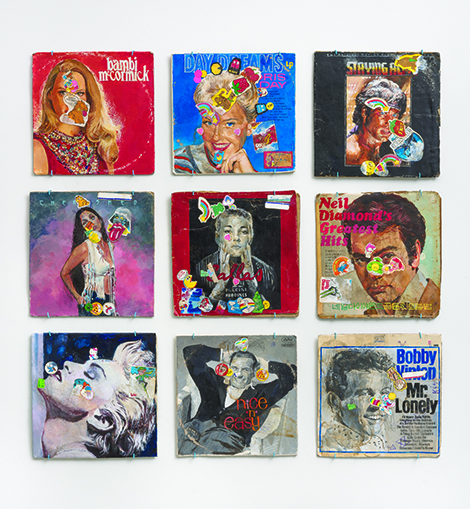Your cart is currently empty!
Kristen Morgin

At first glance the array of objects in Kristen Morgin’s evocative installation “Messages to My Twenty Year Old Self” appear to be those found in a rummage sale: old books and toys, record albums and empty tuna cans, comic books and musical instruments. What is most significant and amazing is that each piece is crafted from unfired clay and meticulously painted to resemble the original. Morgin imbues these creations with life, celebrating both their historical significance and her personal relationship to them. Through thoughtful and often uncanny juxtapositions these salvaged icons and relics of 1970s and 1980s consumer culture take on new meaning.
In The Bradys (Left to Right Top to Bottom): Marcia Brady, Carol Brady, Greg Brady, Jan Brady, Alice Nelson, Peter Brady, Cindy Brady, Mike Brady, Bobby Brady (2015), Morgin recreates the iconic grid of the television series’ opening credits using nine album covers—old, faded, torn, sticker-covered—by singers including Madonna, Doris Day, Neil Diamond and Cher, and equates the personalities of the Brady characters with these albums. Records appear in other works, including the expansive Hollywoodland (2012), an intricate and subtle floor-based sculpture that alludes to the positive and negative associations of Hollywood and Disneyland.

While Morgin’s objects are newly created, they are quite fragile and appear to be old. The pieces range in size from small to large and while some are discrete objects, many are juxtaposed to create disquieting narratives. A Message to My 20 Year Old Me: Sleep Tight (2015), is comprised of an old fashioned doll hardly larger than the paperback copy of Flaubert’s novel Madam Bovary that covers it like a blanket. A Felix The Cat string toy rests on the book’s spine face-down, arms splayed in a position that parallels the doll’s. Morgin’s message—to sleep tight— is ironic as the child has no idea of life’s awaiting tragedies. Similarly, untitled (Tweety Bird) (2014) is a delicate recreation of a dilapidated Tweety Bird toy, its broken pieces held together by string, drained of color and devoid of the joy it once brought.
References to pop culture—Disney characters, the Brady Bunch, Bonanza, the Smurfs—abound in Morgin’s work. Who can help but laugh at Have a Lovely Day or Ponderosa (2014), a sadistic sculpture that depicts the Pillsbury Doughboy’s head trapped under a cinder block on which sits a book of matches from the Ponderosa Steak House that proclaims “have a lovely day.” Or nod at the double entendre of Wallflower (2014), a pathetic image of a smiling flower made from decorated cardboard and an empty tuna can (all rendered in clay).
Nostalgia and ruin are recurrent themes, yet Morgin’s work is as hopeful as it is sad. Her hand-crafted realistic renditions present that which has been discarded and left for naught in a new context. The juxtapositions and narratives she creates inspire reflection and trigger memories of a bygone era that speak to the power of popular culture, and what it means to survive.